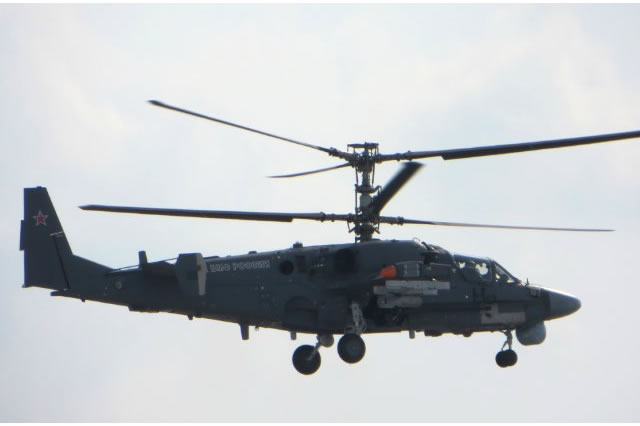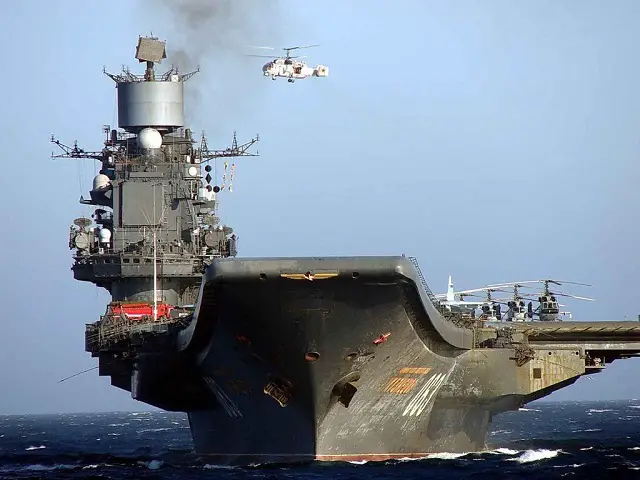Breaking news
Ka-52K as part of Admiral Kuznetsov carrier’s air wing to boost strike capabilities.
| 2016
| |
|||
| a | |||
Naval
Forces News - Russia |
|||
Ka-52K
as part of Admiral Kuznetsov carrier’s air wing to boost
strike capabilities |
|||
Adding
the Ka-52K Katran (NATO reporting name: Hokum-B) ship-based attack/scout
helicopter to the air wing of the Project 11435 (Admiral Kuznetsov-class)
Admiral Kuznetsov aircraft carrier will step up the latter’s strike
capabilities, according to the Izvestia daily. |
|||
 Russian Navy's new Ka-52K Hokum B Naval Attack Helicopter during its first test flight |
|||
The
solution also will allow close air support of amphibious assault operations
and operations in the interest of ground forces at a distance of 200
km. According to Anatoly Sitnov, a former chief of armament, Russian
Defense Ministry, the Mediterranean sortie of the carrier with an updated
air wing on board late this year will vindicate the solution. The simultaneous presence of Mikoyan MiG-29K/KUB (Fulcrum-D) multirole fighters and Ka-52K helicopters in the air wing’s inventory will ramp up the carrier’s tactical performance, enabling her to accomplish a wider range of missions. After she has received the helicopters, the carrier will be capable of not only air defense and deep inland attacks (the usual job done by the carriers), but littoral operations as well, with the latter being typical of versatile amphibious assault ships, e.g. the Mistral. For instance, the carrier will be able to destroy small-displacement ships and craft, suppress the enemy’s shore infrastructure and support amphibious landing operations. She will carry up to 30 attack helicopters, which no other aircraft carrier in the world can do. According to the expert, this could have been achieved with the fielding of the French-built Mistral class LHDs by the Russian Navy. However, Russia did not receive the two ships of the class due to the West-imposed sanctions. The ships have been bought by Egypt instead. Nevertheless, Kamov General Designer Sergei Mikheyev said, it is the deal with the French that prompted Russia to develop its sophisticated Ka-52K ship-based attack helicopter. |
 Russian Navy Aircraft Carrier Admiral Kuznetsov. Picture via Reddit |
|||
By
tradition, Kamov has developed helicopters for the Navy, with the coaxial
rotor design being just the thing for this application. Kamov’s
machines lack the tail rotor, which enables them both to move in confined
spaces safely and to take off and land in any weather, even in storms.
The Ka-52K resolved several confined space basing problems: it has folding
rotor blades and stub wings in particular. Despite its similarity of appearance
with the land-based Army Aviation model, it is an utterly different attack
helicopter. The machine’s advanced main rotor mast allows the blades to be folded, thus reducing the Katran’s size belowdecks. The air conditioning system ensures the smooth operation of the engines in humid maritime environment. However, the key modifications vis-•-vis the baseline land-based model, the Ka-52, lie in the Ka-52K’s tactical capabilities. The land-based Ka-52 is equally effective against enemy manpower, armor, helicopters and armored fortifications. It wields a 30-mm rapid-fire gun, Ataka and Vikhr-1 antitank guided missiles and 80-mm S-80 unguided rocket pods. The Ka-52K’s stub wing is reinforced and can carry a payload of up to a ton. It is this ability that prompted the designers to expand the helicopter’s weapons suite, affording the machine the anti-ship role as well. The up-to-date Kh-31 and Kh-35 cruise missiles carried by the Ka-52K are designed for the job. The helicopter might be equipped with torpedoes as well as part of its modernization. Unlike fixed-wing aircraft, helicopters can operate at a higher pace. They take off and land on deck more quickly than airplanes do, which allows a heavier pressure on the adversary. The arrival of the Admiral Kuznetsov to the Mediterranean will be equal to Russia’s establishing another base in Syria, according to the Izvestia daily. © Copyright 2016 TASS. All rights reserved. This material may not be published, broadcast, rewritten or redistributed. |
|||


























